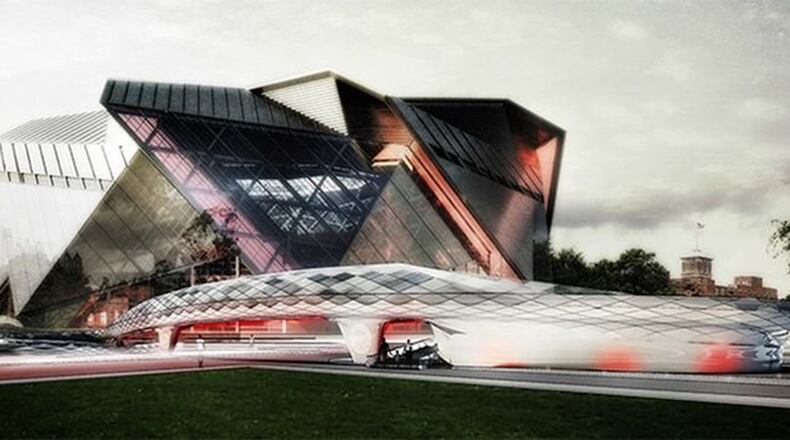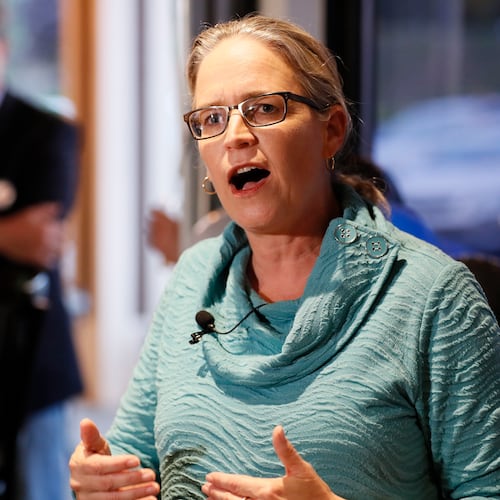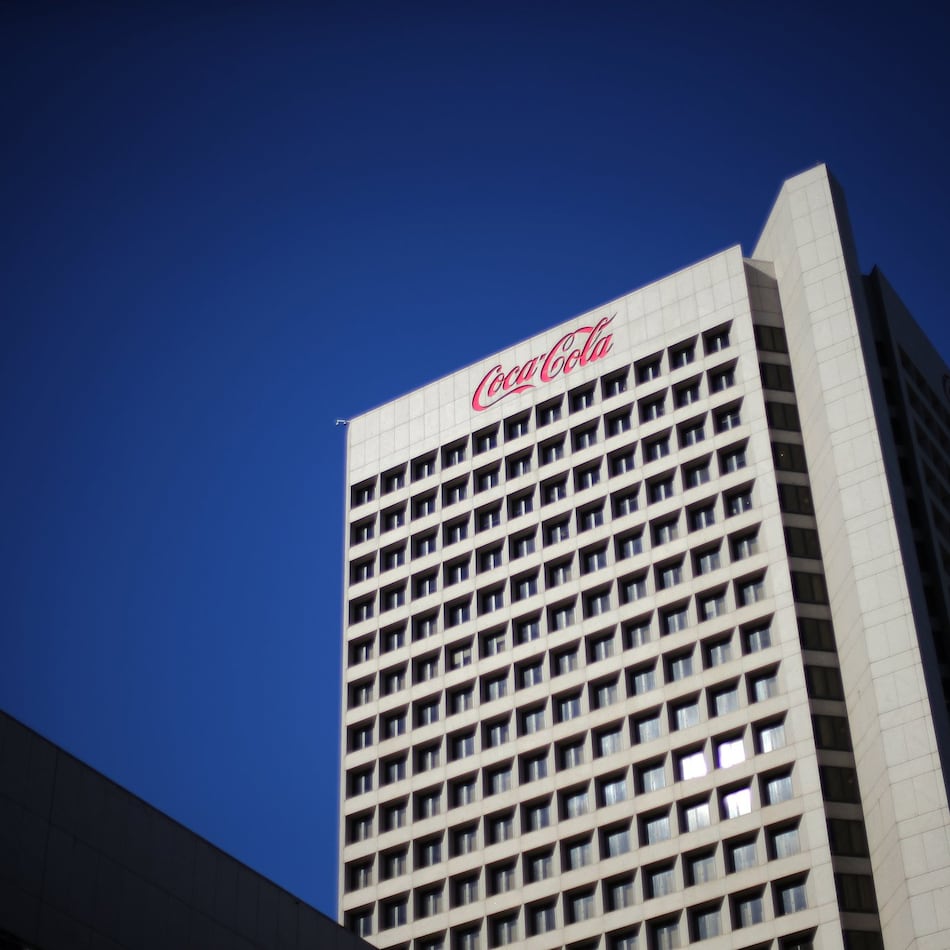Mayor Kasim Reed’s administration told Atlanta City Council members in July that a new pedestrian bridge over Northside Drive would cost no more than $12.8 million, and might not even be that much.
Reed’s team also said the bridge had no connection to the Falcons’ $1.5 billion Mercedes-Benz Stadium, and that it was requested by Vine City residents as part of a negotiation for community improvements to be made in conjunction with stadium construction.
None of those claims are backed up by the public record, based on an examination of the bridge’s construction contract, other documents and interviews with Vine City leaders who helped broker improvements around the new stadium.
In fact, just five weeks after the council voted overwhelmingly in favor of funding the bridge, Reed and Public Works Commissioner Richard Mendoza put their signatures on a contract that estimates the final cost at $23.2 million — an 81-percent increase over the amount approved by council.
In a recent interview, Mendoza maintained that the project budget is still $12.8 million, because that is the amount approved by city legislators.
“This document does not place the city on the hook for that full $23 million,” Mendoza said. “And if the council disapproves, we’re not obligated to pay that additional amount.”
The 500-page contract, obtained by The Atlanta Journal-Constitution through Georgia’s open records law, includes a detailed budget that estimates bridge construction costs big and small — from concrete decking and retaining walls to dumpsters and port-a-potties.
It says the project will have two phases, and funding beyond the $12.8 million already approved will have to go back to the council for a vote. The first phase is to be paid in chunks of $12.8 million and $4.5 million; the second phase in a lump sum of $5.8 million, according to the contract.
Mendoza told the AJC that the bridge is a result of more than 50 community meetings, at which residents discussed improvements and programs for westside neighborhoods. Some of those ideas, codified in an agreement called the Community Benefits Plan, will be funded with $15 million from the Westside Tax Allocation District and $15 million from the Arthur M. Blank Family Foundation.
“What can not be lost here is that this is a community-driven project,” Mendoza said in a December interview. “This bridge was asked for by the Vine City neighborhood. It is the means by which we are responding to the desires of Vine City.”
Katrina Taylor Parks, Mayor Reed’s deputy chief of staff, told the council the same thing on July 12 — that the bridge “was the result of … over 50 community meetings.”
“This is not for the benefit of the stadium,” Taylor Parks told the council.
Rev. Anthony A.W. Motley, a major participant in helping craft the Community Benefits Plan, scoffed at the assertion.
“To try and justify the bridge on the basis of a connection to poor people in the community is an insult to everything that we have proposed, particularly as it relates to the Community Benefits Plan,” Motley said. “The bridge has nothing to do with the community, and to say that it does shows contempt for the community and a flagrant disregard for the truth.”
But Tillman Ward, a lifelong resident who chairs the land use and transportation committee for the Vine City Civic Association, said he supports the bridge because it has been a community need since the Georgia Dome opened in 1992.
“It’s an opportunity to make up for lost time,” Ward said. “We have an opportunity to reconnect Vine City to downtown in a way that we can all be proud of.”
Records: Bridge all about the stadium
The city’s paperwork on the project doesn’t support the idea that it is being built for westside neighborhoods, either.
A project description in the city's solicitation of bids to construction companies says the bridge's purpose is to "provide pedestrians safe and unimpeded access to the Mercedes-Benz Stadium." It doesn't mention connecting the neighborhoods to downtown.
The original resolution in front of the council’s Utilities Committee in July had similar language, and caused one councilman to abstain from the vote until stadium references were removed.
In an interview with the AJC, Taylor Parks said both of those documents were written in error, and should have mentioned connecting westside neighborhoods to downtown as the bridge’s purpose.
And a November 2015 study of the bridge, titled “A Path to Connectivity,” discusses the project in terms of the impact it will have on fans going to the stadium.
“Cylindrical in section, the form gives the visitor the feeling of passing through the tunnel onto the field,” the report says. “The result is a grand introduction to the event space, a strong sense of arrival that the stadium commands.”
“Mother” Mamie Moore, president of the English Avenue Neighborhood Association, said her group never asked for a bridge. Moore said she only learned of it in September, during a presentation by Central Atlanta Progress on plans to improve intersections, lighting and sidewalks along Northside Drive.
“This bridge has never been on the agenda for the English Avenue Neighborhood Association because it has never been brought to us,” Moore said.
Ratified by city council in 2013, the Community Benefits Plan is a 10-page document that lists a broad spectrum of community needs — from job training programs and code enforcement to business initiatives and affordable housing.
The document lists 10 “catalytic projects,” including transit-oriented developments at the Vine City MARTA station, but doesn’t mention a bridge. Likewise, a list of 15 transportation and infrastructure projects in the agreement makes no mention of a pedestrian bridge.
A spokeswoman for Reed said the bridge will not be funded out of the $15 million in taxpayer money committed to the benefits plan. She said the administration has made a coordinated effort across many city departments to revitalize westside neighborhoods — efforts that go beyond the tax allocation district funds and the bridge.
But a majority of the $12.8 million approved for the project so far will come from the city’s general fund and Renew Atlanta bond premiums — pots of money that could be spent on other community improvements.
“There are 20 other places I’d rather see $20 million spent,” said John Gordon, founder and co-chairman of the nonprofit Friends of English Avenue.
Translucent skin and $1.8 million for lighting
At $23 million, the 110-foot span over Northside Drive would be double the price of the $11.5 million, 1,100-foot bridge Cobb County is building over Interstate 285 to SunTrust Park.
The futuristic, swirling design of the Atlanta bridge appears to be a match for the new Mercedes Benz Stadium, set to open next football season. The bridge contract sets a Dec. 31, 2017, deadline for its completion.
It will connect the Vine City MARTA station with the stadium, at the point where the Georgia Dome currently sits. Long, curling ramps on each end will expand the bridge’s overall length to 325 feet — about the length of a football field — and are designed to meet Americans with Disabilities Act guidelines in lieu of elevators.
The single largest expense is $3.6 million for the bridge’s outer skin: a translucent, diamond-shaped architectural feature that will be highlighted with $1.8 million in lighting effects, according to the budget. The outer skin and lighting make up the majority of cost associated with the project’s second phase of construction.
“The accent lighting will include several elements, which will create a unique visual experience that will set this bridge apart from any other bridge in the Southeastern U.S.,” says the contract, which also refers to the bridge as a “world-class structure.”
The contract says the city could save $7.7 million by scrapping the second phase of construction, which gives the project its unique aesthetic. The same section of the contract mentions that the city could add $2.7 million with “light gardens” on each ramp along with lighted handrails and cable rails along its span.
When asked if it is important to build an elaborate and architecturally pleasing bridge for the Falcons, Mendoza said it is important for the community.
“It’s important that we don’t build Vine City residents an ugly bridge,” he said. “They expect us to deliver a quality bridge, one that they can take pride in and that they can look to and say: ‘This is part of our community.’ And they hold us to a very high expectation.”
Taylor Parks said $12.8 million already appropriated will deliver “a successful and safe pedestrian bridge,” although she could not say where the city would save money to keep the first phase within that amount.
“The question is whether that bridge will have all the bells and whistles associated with it,” Taylor Parks said in the interview.
Mike Dobbins, a professor in Georgia Tech's College of Architecture, was critical of the bridge at a cost of $13 million, saying it is about the same amount "the neighborhood struggled to wrest out of the city for neighborhood improvement."
With $23 million, the neighborhoods could have as much as 40 miles of sidewalks; 400 refurbished homes; or 4,000 street lights — all of which would be way more beneficial to the community, Dobbins said.
“As far as I can tell, there is virtually nobody out there … that says this bridge is a preferred alternative,” said Dobbins, whose students studied ways to reconnect westside neighborhoods with downtown. “The only people who say this thing makes any sense, even at $13 million, is the mayor and Arthur Blank.”
‘There are other needs’
Councilman Ivory Lee Young, who represents the area, is a supporter and sponsored the legislation funding the project at $12.8 million. Young said he backs the project because it will help people move around between the neighborhoods, downtown, Centennial Olympic Park, the Georgia World Congress Center, the stadium and a planned hotel.
“This bridge absolutely an essential enhancement” for the community, Young said.
Young was unaware of the contract and its higher project budget until told of it by the AJC. The councilman said he was going to “pursue a better understanding” of both.
None of eight other council members polled by the AJC were aware of the higher project budget, either.
Councilman Alex Wan abstained from voting on the bridge at the July committee meeting because of his concern that the project violated a city resolution not to spend general fund money on the stadium. Taylor Parks responded to his comment by saying that he had the wrong version of the resolution, and that the administration had an updated document that removed all mention of the stadium.
Wan missed the bridge vote at the July council meeting, but said he would not have supported it.
“There were too many references and documents and conversations about that relationship between the bridge and the stadium,” Wan said in an interview. “I never got comfortable with arguments the administration presented to me that it was not for the stadium.”
Councilwoman Felicia Moore felt the same way, saying the bridge seems “to go back on that resolution.”
“It just didn’t make sense to me,” Moore said. “It’s expensive; it’s elaborate; there are other needs. So I just voted no.”
Bridge funding passed by a 12-1 vote.
Northside Drive Pedestrian Bridge estimated budget:
$3.9 million: Architectural aluminum cladding (outer skin)
$3.3 million: Mobilization
$2.2 million: Design and engineering
$2 million: General conditions (fencing, dumpsters, contingency, permitting, project management, etc.)
$1.8 million: Bridge superstructure concrete
$1.7 million: Electrical and lighting
$1.7 million: Sitework, demolition, clearing
$1.5 million: Retaining walls, concrete walkway
$1.4 million: Bridge foundations
$891,018: Bridge beams
$746,000: Traffic control
$622,000: Bridge substructure concrete
$520,000: Owner's allowance for differing site conditions, soil removal, additional site improvements
$425,000: Sidewalks, curbs
$23,222,524: Total cost
Source: City of Atlanta
For the stadium or for the community?
“There is no connectivity between the stadium and this pedestrian bridge.”
— Deputy Chief of Staff Katrina Taylor-Parks during a council committee meeting in July.
“The proposed bridge will provide pedestrians safe and unimpeded access to the Mercedes-Benz Stadium.”
— Atlanta's Request For Proposals soliciting bids for the project in August 2015.
“This is a community-driven project. This is a bridge that was asked for by the Vine City neighborhood. It is the means by which we are responding to the desires of Vine City.”
— Atlanta Public Works Commissioner Richard Mendoza in a December interview with the AJC.
“The bridge has nothing to do with the community and to say that it does shows contempt for the community and a flagrant disregard for the truth.”
— Rev. Anthony A.W. Motley, a major participant in the Community Benefits Plan negotiations, in a December interview with the AJC.
About the Author
Keep Reading
The Latest
Featured





